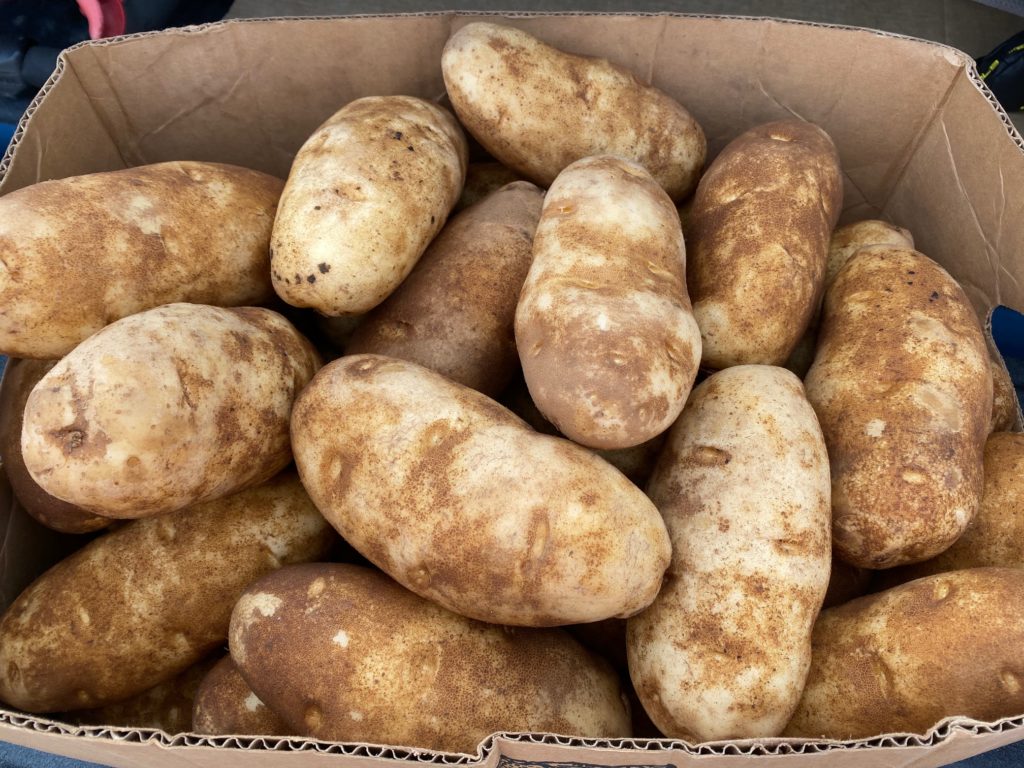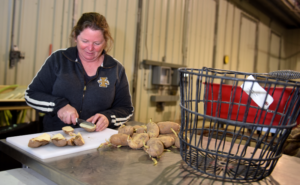
Improving quality of Idaho potatoes in the retail sector
When retail grocers complain about defects in fresh potatoes, it’s something you pay attention to when your state happens to be famous worldwide for growing potatoes.
What began in 2017 as an effort to remedy a quality issue within Idaho’s fresh-market potato sector eventually developed into a well-researched offensive to limit defects found in both fresh and processing potato markets.
Over the past four years, two University of Idaho (UI) potato researchers — Mike Thornton and Nora Olsen — have monitored and followed the journey of Idaho potatoes from harvest to storage and then from out of storage and in transit to distribution centers. Their quest was to find various sources of potato defects with the ultimate goal of removing the causes of the defects and in the process improving the quality and marketability of Idaho’s potatoes.
Thornton, a professor of plant sciences working primarily on potatoes and onions at the UI Parma Research & Extension Center, said that the main source of potato defects is related to impact bruising. He said impact bruise-related issues make up the majority of rejection notices of fresh potatoes. That includes shatter bruise, black spot, as well as rot instances that happen through shatter bruise.
“Like 70% of all the rejection notices are tied to those things that are related to impacts that happen at harvest or while we’re handling them or shipping them,” Thornton said.
Olsen, a professor specializing in potato storage at the UI Kimberly Research & Extension Center, said that the many factors that create quality control issues include the variety’s susceptibility to bruising, having ideal temperatures for harvesting, storage and transportation and late-season soil moisture on potato bruising.
“There’s just so many layers to bruise, we just need to keep peeling it back and figuring out what are the bigger targets,” Olsen said.
Olsen and Thornton attempt to include bruise research as often as possible.

“We did like 17 different projects,” Olsen said, “any project that we had going on if we felt that ‘hey, we can add in a bruise component,’ we did.”
Thornton and Olsen have spent countless hours over the past four years observing harvest practices, measuring the drop heights of harvest equipment, the speed of the rollers and the amount of padding and quality of conveyor belts moving the potatoes into storage, as well as moving the potatoes out of storage and to distributions centers around the country.
Drop heights was a particular area of interest. One of Olsen’s graduate students, Rebecca Hendricks, spent two years studying how different drop heights and impact forces affected the bruising capacity on different varieties.
“Part of why that is important is that in the last 50 years most of the bruise information is on (Russet) Burbank,” Thornton said. “So, we were really in a lot of unknowns when you start switching varieties, even with Norkotah. There’s just not a lot of information out there on how Norkotah responds to impact or when you put it in storage, so we really thought this was a big void in our knowledge.”
Beyond bruising
Research has extended well beyond bruise impact equipment, as they also looked at the biochemical component and soil healthy fertility.
“What we’re tying to do too is to better understand the questions that come into our office, ‘why are my potatoes bruising like this?’” Olsen said. “There’s some go-tos when people bring samples in to us. Let’s talk about maturity. Let’s talk about fertility. Let’s talk about some of these (other) things.”
They have also overseen production of a series of instructional videos on best management practices to avoid potato bruising. The videos illustrate proper techniques to minimize drop heights in the field operations of windrowers, potato harvesters, stingers, conveyors and pilers when transferring potatoes from trucks to the storage cellars. And when moving potatoes out of storage the correct operation of the potato scooper and the drop height of the conveyor into the trailer. The videos come with either English or Spanish narration.
An important partner throughout their quality control research was Walmart.
“They (Walmart) have this massive data set from all the distribution centers,” Thornton said. “They have the best data set that they could share with us where we could see what’s going on in real time. They sent us those every week.”
Olsen said that Walmart provided a lot of in-kind information and a lot of details that provided insight into the data they were collecting.
“You can collect any data but if you don’t have the context behind it then it’s hard to put it into action,” Olsen said. “Walmart did a nice job of doing that and then, also, a lot of our packers were great, our fresh packers were so welcoming and helpful, trying different things and being very open with us as well. I think that was key.”
One of the Idaho shippers working with Thornton and Olsen was Wada Farms out of Pingree. Wada Farms is one of the major suppliers of Idaho potatoes to Walmart.
Eric Beck, director of marketing for Wada Farms, said that Walmart was the driving factor behind the project. According to Beck, Walmart wanted to identify not only ways to promote potato health at harvest but specifically for potatoes coming out of storage.
“It was pretty cool to see a retailer say ‘we want to be part of the process,” Beck said. “Let’s utilize our resources and let’s work together to find a good result not just for Walmart’s customers but for the industry, in general.’”
Beck said that Thornton and Olsen “did tremendous amounts of sampling on the product that was coming inbound that day in the storages getting data from that aspect of it so we could see from storage to final destination what were the core factors that were affecting potato health at that time.”
After sampling potatoes coming out of storage, Beck, Thornton and Olsen would meet the trucks at their final destinations: Walmart distribution centers (DC) in Utah, North Carolina, South Carolina, Arkansas and New York.
“We met them when they opened up the (trailer) doors,” Olsen said.
“We were able to observe (Walmart’s) quality control and inspection processes in order to see if there’s any anomalies and then identify the consistencies that we’re seeing across the board,” Beck said.
The group was impressed with Walmart’s quality control (QC) personnel.
“They’re really dedicated, trying to do a good job of detecting the actual quality so actual problem lots get tagged,” Thornton said. “They’re not trying to tag lots as an issue that aren’t an issue. They’re trying to do a really good job.”
Takeaways
Beck said that there were several items they identified during the process that improved their understanding of how to improve the quality of potatoes from the field to the consumer’s table.
“I think every little bit kind of helps overall to the bigger picture,” he said.
One factor that seemed to stand out was some trailers were not always kept at a temperature range of between 40 and 45 degrees. Thornton said that when checking the tractor trailer logs that would find that some trailer temperatures never dropped below 50 to 55 degrees.
“They’re not meeting the conditions in the trucks that they think they’re getting and that’s contributing to some of this loss in quality,” he said.
Travis Blacker, director of industry relations for the Idaho Potato Commission, said that the IPC spent an estimated total of $250,000 for Olsen and Thornton’s project.
“This project easily paid for itself,” Blacker said. “This wasn’t just for shippers, this was for all growers. Better practices and helping with harvest and handling and storage and packing. This is not just fresh pack growers but process growers as well. Really, it affects the bottom line of returns going directly back to the growers.”
Thornton said that the success of the program could be seen in the reduction of rejected shipments at the distribution centers.
“The rejection notice data speaks for itself,” Thornton said. “We’ve seen a steady drop every year in the number of rejections.”
Thornton said that Walmart has started applying some of the lessons learned to other lines of fresh produce.
The key message from the work was the unity among the fresh industry to improve their quality controls, Thornton said.
“I think the best thing about this project was it brought the whole fresh industry’s attention to ‘hey, we got to work hard to make sure we have quality potatoes 12 months of the year because one of our biggest customers is asking us to do that,” he said. “I think all Nora and I did was give them some tools and information, but they did all the work.
“The fact that rejections have gone down is because shippers have started paying more attention to the quality assurance process.”
The success of this project does not close the chapter on their research. Their current emphasis is on Clearwater Russet.
“Just trying to get the idea does that (Clearwater) susceptibility at some point change in terms of maturity. Because we just need to help ourselves ask the right questions too when some of these bruise concerns come in,” Olsen said. “There’s a lot to ask and how do you start to narrow it down and so that’s some of the future projects that we’re working on.”
Along with that, they are looking at shatter bruise and its association with weight loss in storage.
“We know that shatter bruise was one of the major quality concerns in the Walmart study. It’s also concerns for disease, dry rot, soft rot, all the other things, but let’s add on another quality issue that we have is weight loss in storage and we just want to see that association as well,” Olsen said.
Top photo: Travis Blacker, Idaho Potato Commission







